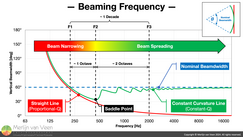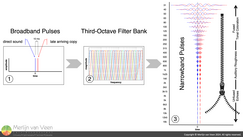
- Details
 Figure 1Our industry is notorious for its ambivalence regarding consensus on definitions, and the definition of headroom is no exception. A recent Facebook poll revealed a 20/80 divide between the two most common definitions.
Figure 1Our industry is notorious for its ambivalence regarding consensus on definitions, and the definition of headroom is no exception. A recent Facebook poll revealed a 20/80 divide between the two most common definitions.
Headroom's ambiguity may stem from a paradigm shift in audio technology. And the solution could be straightforward. Where simply adopting a new term might end the status quo.
- Details
 Figure 1This may come as a shock — coming from the author of the Subwoofer Array Designer — but over the years I have grown an increasing dislike for horizontal subwoofer arrays.
Figure 1This may come as a shock — coming from the author of the Subwoofer Array Designer — but over the years I have grown an increasing dislike for horizontal subwoofer arrays.
The only thing they really have got going for them, is their left‑to‑right spatial uniformity — provided — they do not fall victim to one honest mistake.
- Details
 Figure 1Low‑pass filters introduce — negative — phase shift (Figure 1.1) which does not violate causality (cause and effect). That is, the filter's output does not occur before its input.
Figure 1Low‑pass filters introduce — negative — phase shift (Figure 1.1) which does not violate causality (cause and effect). That is, the filter's output does not occur before its input.
Conversely, high‑pass filters introduce — positive — phase shift (Figure 1.2) which paradoxically suggests the filter's output occurs before its input. In other words: time travel...
- Details
 Figure1The "Beaming Frequency" is where curved line‑source behavior strays from straight line‑source behavior. Line arrays are hybrid solutions that exhibit both straight as well as curved line‑source behavior.
Figure1The "Beaming Frequency" is where curved line‑source behavior strays from straight line‑source behavior. Line arrays are hybrid solutions that exhibit both straight as well as curved line‑source behavior.
The former causes Proportional‑Q — in the vertical plane — whereas the latter Constant‑Q. And there will be an inevitable frequency span where one behavior transitions into the other. During which vertical beamwidth will narrow, by as much as one‑third less than nominal. The frequency where vertical beamwidth is at its narrowest is historically known as the "Beaming Frequency".
- Details
 Figure 1Audio practitioners and musicians alike are intimately familiar with slapback echoes when a snare drum's sound bounces off a specular rear wall or balcony face, a phenomenon less frequently observed with kick drum sounds. This discrepancy hints at a frequency‑dependent echo perception‑threshold.
Figure 1Audio practitioners and musicians alike are intimately familiar with slapback echoes when a snare drum's sound bounces off a specular rear wall or balcony face, a phenomenon less frequently observed with kick drum sounds. This discrepancy hints at a frequency‑dependent echo perception‑threshold.